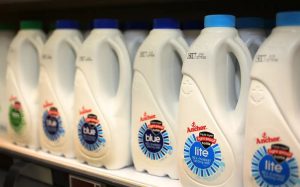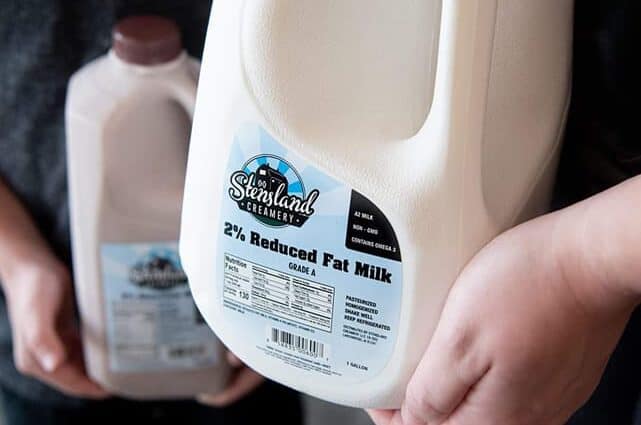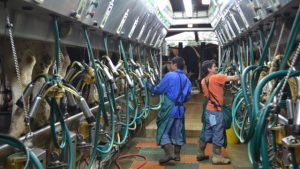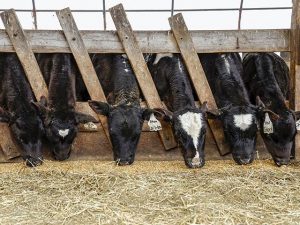
You’ll recall July milk production was down 0.5% from July 2022. The Dairy Products report showed the results.
Cheese production totaled 1.162 billion pounds, down 0.7% from June and down 0.7% from July 2022. Output in the first seven months of 2023 totaled 8.2 billion pounds, up just 0.3% from 2022
Italian cheese output totaled 481.6 million pounds, up 0.2% from June but 1.5% below a year ago. American output, at 475.2 million pounds, was up 0.3% from June and up 0.2% from a year ago. Mozzarella totaled 382.2 million pounds, down 2.6% from a year ago.
Dry whey production totaled 88.2 million pounds, up 2.7 million pounds or 3.1% from June, and up 2.9 million or 3.4% from year ago. Stocks grew to 86.9 million pounds, up 3.2 million pounds or 3.9% from June and up 14.8 million or 20.6% from a year ago.
Nonfat dry milk output dropped to 134.9 million pounds, down 43.1 million pounds or 24.2% from June and down 30.8 million or 18.6% from a year ago. Stocks fell to 283.3 million pounds, down 15.4 million pounds, or 5.2% from June, and down 49.8 million or 15.0% from a year ago.
Skim milk powder production jumped to 62.6 million pounds, up 25.2 million pounds or 67.3% from June, and up 1.6 million or 2.6% from a year ago.
The report was viewed as bullish for cheese and powder and bearish on butter.
Less milk ahead
The Agriculture Department lowered its milk production forecasts for 2023 and 2024 in Tuesday morning’s World Agriculture Supply and Demand Estimates, based on an expected decline in cow numbers, “reflecting the average July 2023 cow number reported in the recent Milk Production report. The reduction in cow numbers is expected to continue through 2023 and into the first half of 2024 as returns remain under pressure.”
Output-per-cow for 2023 was forecast to increase at a lower rate than previously expected on recent data and the expected impact of high temperatures during the summer. The forecast of milk per cow for 2024 was unchanged.
Pulse moves higher
Tuesday’s GDT Pulse saw 2.1 million pounds of Fonterra whole milk powder sold, down from 2.2 million in the Aug. 29 Pulse, and at $2,655 per metric ton, up $205 from the last Pulse and up $25 from last week’s GDT.
HighGround Dairy stated that “with 37 participants, this was the largest turnout for the Pulse since August 2022 as the rise in the C2 Regular WMP price drove more buyers to the platform. However, with only 12 winning bidders and less than 100% of product sold, it is clear that uncertain macroeconomic influences continue to weigh on market sentiment while overall global demand remains weak.”
GDT rebound?
Rabobank analyst Lucas Fuess, speaking in the Sept. 11 “Dairy Radio Now” broadcast, said it remains to be seen if there was a bona fide turnaround in the Sept. 5 GDT. WMP was up, he said, but SMP was still down, adding that New Zealand’s milk production season peaks in October and Fonterra has twice lowered its milk price expectations, so dairy farmers are facing a tough economic challenge.
While China’s depressed economy and purchases are on everyone’s minds, Rabobank released its “Global Quarterly,” focusing in part on the milk supply, which is contracting in most key regions like the U.S., European Union and New Zealand.
“That sets us up with a supply side that isn’t necessarily firm,” Fuess said. “Any sense of a demand recovery, especially if it comes quicker than expected, could mean we have finally reached the bottom on prices.”
With China becoming the world’s third largest milk producer, its global purchases will be reduced, according to Rabobank, but China will not be self-sufficient and thus will remain a big buyer of dairy products, Fuess concluded.
Uncle Sam to help
The Agriculture Department announced that it will provide financial assistance to dairy farmers affected by natural disasters. The National Milk Producers Federation stated that “the Milk Loss Assistance program will compensate eligible dairy farms and processors for milk dumped due to qualifying disaster events in 2020, 2021 and 2022, including droughts, wildfires, hurricanes, floods, derechos, excessive heat, winter storms and smoke exposure.” Dairy farmers and cooperatives can sign up for the program through Oct. 16, 2023.
Powder strengthens
CME block Cheddar climbed to $1.9625 per pound last Wednesday but closed Friday at $1.9250, down 2.50 cents on the Labor Day holiday shortened week but 0.75 cents above a year ago.
The barrels saw their Friday finish at $1.8275, 4.25 cents lower on the week, 10.50 cents below a year ago, and 9.75 cents below the blocks. Only 3 loads of block traded on the week at the CME and 2 of barrel.
The cheese was unchanged Monday but the blocks dropped 5.50 cents Tuesday to $1.87 on 1 trade. The barrels were down 2.25 cents Tuesday on 3 trades, slipping to $1.8050.
Milk availability continues to tighten in the Midwest, according to Dairy Market News. Cheesemakers say several milk handlers have “gone silent on offers.” Spot loads at mid-week were reportedly $1 over Class III or higher. Cheesemakers are growingly concerned about meeting demand, particularly mozzarella and pizza cheesemakers. Excessively available milk throughout the winter and spring kept cheesemakers very busy but that’s not the case currently, says DMN.
Butter climbed to $2.73 per pound last Thursday but closed Friday at $2.68, up 2 cents on the week, reversing two weeks of losses, but was 49 cents below a year ago, with 49 sales reported for the week.
Monday’s butter was unchanged but it jumped 4.25 cents Tuesday, to $2.7225, on 4 trades.
Cream availability varies but the holiday weekend provided butter plants extra product. Cream access is slowing and expected to tighten as heat and humidity crimps milkfat output at the farm. Retail butter demand is steadily increasing and food service demand is notably improved, says DMN.
Cream tightness also eased in the West but post-holiday volumes are slipping. Near-term cream is anticipated to be tight in the West. Spot loads are available but more limited. The tighter availability and higher spot prices are keeping buyers at bay, says DMN.
Grade A nonfat dry milk fell to $1.0575 per pound last Tuesday, lowest CME price since Nov. 5, 2020, but rallied Wednesday, and closed Friday at $1.10, up 2.50 cents on the week but still 47.50 cents below a year ago, on 21 sales.
The powder was unchanged Monday and Tuesday.
Dry whey hit 32 cents per pound last Tuesday, highest since May 8, but closed Friday at 30.25 cents, down a quarter-cent on the week and 15.50 cents below a year ago. There were 11 sales reported on the short week.

























